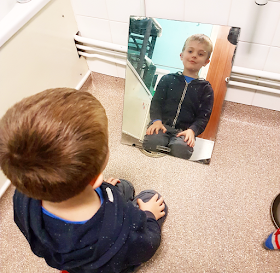The boys have gone through a stage where they are fascinated with their own reflections and how light can reflect off of surfaces. To the point that I often have to hurry James along where he keeps stopping to look at himself in car windows!
With this in mind I thought we would do a little investigation.
Talk
To discuss the differences that the varied surfaces. Do they all reflect? Do the different shapes change how the reflection appears? Discuss about the different things they see and describe features including concave and convex.
Key Words
Reflect, Reflection, Light, See, In front, Behind, Up/Down, Different, Back to front, Reflectors, Concave and Convex
Experiment
Using everyday objects, like books and see that reflections and what might change.
Using a direct light can we create reflections and movement?
Can we create colours reflecting?
Learning Goals
Select and use activities and resources independently
Communication, Language and Literacy
Extend their vocabulary, exploring the meanings of new words.
Knowledge and Understanding
Investigate objects and materials by using all of their senses as appropriate.
Find out about and identify some features they observe.
Creative Development
Explore colour, texture, shape, form and space in two and three dimensions.
Time to explore!
We started out by using a normal mirror and describing what we could see. Both boys were able to describe themselves and the surrounding room. A plain mirror provided a great stable understanding that was easy to allow them to refer to previous knowledge.
We also took the time to put a book in front and see that what we actually see is the reverse and the book, although reflected back, had writing going back. This was great to show that reflections are not always an exact copy of what you see.
With that in mind I asked them what would happen if we had a curved reflective surface or mirror.
Using a chrome bowl (Scales bowl) we looked to see what we could see. The boys noticed that although they could still see themselves that their faces and heads were distorted. I asked why and it did take a bit of time to realise that it was down to the surface shape. I then introduced that the bowl had a concave shape and explored what that meant and how it bent the shape of the reflection.
Following on from the bowl we looked at chrome surface of a hoover. Again this showed a distorted shape and allowed the reflection to become different. Interestingly the boys realised that it was due to the shape but automatically declared the fact that it was "concave". This allowed us to discuss the difference between concave and convex.
We next used the surface of a CD. Both boys were able to identify the reflections but instantly noticed the colours being shown compare to the other reflective surfaces we have used.
I discussed how the CD, very much like a soap bubble, is created by constructed and destructive interference of the light hitting the surface. In the same way, when you stand in front of a window/glass that an image is reflected back. Most of the light passes through the window but some of the light that travels through travels at a slightly shorter distance. On a CD, the surfaced has ridges and is also mirrored so the colours become more intense.
To extend further the boys needed to see if light can be directly reflected.
We sealed ourselves off into our bathroom where there isn't a window and only artificial light. Using a tube, a torch and a mirror we explored reflecting directed light.
We started by pointing the light and tube at the wall. In this instance we looked around to see if we could see any reflective light in the room to conclude that not all surfaces would reflect it.
Next we used the plain mirror.
As seen above the boys instantly had the reflected light. Directing it straight at the mirror and at an angle allowed the circular light to appear by their feet.
Against a black piece of card the boys shown the light against the CD. They found that the directed light in the darkness made the colours appear brighter.
They then set up the mirror opposite the CD to see what would happen!
This was fantastic! As you can see the light magnified in the shape of the CD.
Next they continued to reflect different reflective surfaces and light against the mirror.
This took an afternoon and was fantastic to see the boys explore and learn! The different shapes and surfaces meant that we had great discussions and more so that they met all of the targets that I was looking for at the start.
They used all the vocabulary points as well as learning the difference between concave and convex. They used their senses and described what they could see and used this to explore independently when reflecting light.
What do you think? Would you give this a go?














This looks so cool! I can't believe how much I've forgotten from school days and this stuff is so simple! James looked like he was really into it
ReplyDeleteIt looks like you have been having a lot of fun as well as learning...
ReplyDeleteThis looks like a fun experiment. I think whatever children are learning about, they learn better when it's something they're interested in and you make it exciting for them. Great photos too.
ReplyDeleteNat.x
Brilliant experiment, you certainly make learning boys they're fascinatined.
ReplyDeleteThis is great. My boys went through this stage too - hours spent playing around with mirrors, torches, magnifying glasses. What a lovely way to explore this topic :)
ReplyDelete